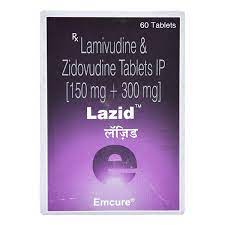Duovir EP 150 mg/300 mg Tablet 60s LAMIVUDINE + ZIDOVUDINE

How long does it take for combination of Lamivudine and Zidovudine to work?
Lamivudine and Zidovudine are antiretroviral medications used to treat HIV. They work by inhibiting the replication of the virus, which helps to reduce the viral load in the body. The time it takes for these medications to start working can vary depending on the individual and the stage of the infection. Generally, patients may begin to see a reduction in viral load within a few weeks of starting treatment. However, it is important to continue taking the medication as prescribed to achieve the best results. Both medications share the common goal of reducing the amount of HIV in the body, but they do so through different mechanisms.

How do I know if combination of Lamivudine and Zidovudine is working?
The benefit of Lamivudine and Zidovudine is primarily assessed by measuring the patient's viral load and CD4 cell count. A successful treatment outcome is indicated by a significant reduction in viral load, ideally to undetectable levels, and an increase in CD4 cell count, which reflects improved immune function. Regular monitoring through blood tests helps to evaluate the effectiveness of the treatment and guide any necessary adjustments. Both medications aim to achieve these outcomes by inhibiting the replication of the HIV virus.

Who should avoid taking combination of Lamivudine and Zidovudine?
Important warnings for Lamivudine and Zidovudine include the risk of lactic acidosis and severe hepatomegaly with steatosis, which can be life-threatening. Zidovudine is contraindicated in patients with significant bone marrow suppression due to its potential to cause anemia and neutropenia. Both medications should be used with caution in patients with liver disease. Regular monitoring of liver function and blood cell counts is essential to detect any adverse effects early. Patients should be informed of these risks and advised to report any unusual symptoms promptly.

Can I take combination of Lamivudine and Zidovudine with other prescription drugs?
Lamivudine and Zidovudine can interact with other antiretroviral drugs, potentially affecting their efficacy or increasing the risk of side effects. Zidovudine, in particular, may interact with drugs that suppress bone marrow function, such as ganciclovir or interferon, leading to increased risk of anemia or neutropenia. Both medications require careful consideration when used with other HIV treatments to avoid overlapping toxicities. Patients should always inform their healthcare provider of all medications they are taking to manage potential interactions effectively.

How effective is combination of Lamivudine and Zidovudine?
The effectiveness of Lamivudine and Zidovudine in treating HIV is supported by clinical trials and studies that demonstrate their ability to significantly reduce viral load and increase CD4 cell counts. Lamivudine works by inhibiting the reverse transcriptase enzyme, while Zidovudine incorporates itself into the viral DNA, causing chain termination. Together, they provide a potent combination that enhances the suppression of the virus. Both medications have been shown to improve immune function and delay the progression of HIV-related diseases, making them a cornerstone of antiretroviral therapy.

Are there harms and risks from taking combination of Lamivudine and Zidovudine?
Common side effects of Lamivudine and Zidovudine include headache, nausea, fatigue, and gastrointestinal disturbances. Zidovudine may also cause anemia and neutropenia, which are significant adverse effects that require monitoring. Both medications can lead to lactic acidosis and hepatomegaly with steatosis, which are rare but serious conditions. Patients should be aware of these potential side effects and report any unusual symptoms to their healthcare provider. Despite these risks, the benefits of controlling HIV infection generally outweigh the potential adverse effects.

Are the medicines in combination of Lamivudine and Zidovudine safe to take together?
Lamivudine and Zidovudine can interact with other medications that affect bone marrow function, such as ganciclovir, leading to increased risk of hematological side effects like anemia. Zidovudine may also interact with drugs like ribavirin, which can exacerbate its side effects. Monitoring for these interactions involves regular blood tests to check for changes in blood cell counts and liver function. Healthcare providers should be informed of all medications the patient is taking to adjust dosages or switch medications if necessary to minimize interaction risks.

Can I take combination of Lamivudine and Zidovudine if I am pregnant?
Lamivudine and Zidovudine are considered relatively safe for use during pregnancy, as they have been shown to reduce the risk of mother-to-child transmission of HIV. Zidovudine, in particular, is often used during labor and delivery to further minimize this risk. Both medications have been studied in pregnant women, and while they are generally well-tolerated, potential risks to the fetus cannot be completely ruled out. Healthcare providers should carefully weigh the benefits and risks when prescribing these medications to pregnant women.

Can I take combination of Lamivudine and Zidovudine while breastfeeding?
Lamivudine and Zidovudine are excreted in breast milk, and their safety during breastfeeding is not fully established. While the benefits of breastfeeding must be weighed against the potential risks of HIV transmission and drug exposure to the infant, it is generally recommended that HIV-positive mothers avoid breastfeeding to prevent transmission of the virus. Both medications share this common concern, and healthcare providers should discuss alternative feeding options with mothers undergoing treatment to ensure the safety of the infant.

What disease or symptom is combination of Lamivudine and Zidovudine used for?
Lamivudine and Zidovudine are primarily indicated for the treatment of HIV infection. They are used in combination as part of antiretroviral therapy to manage the disease, reduce viral load, and improve immune function. While both medications target the same condition, they do so through different mechanisms, enhancing their overall effectiveness when used together. Additionally, Zidovudine is sometimes used to prevent mother-to-child transmission of HIV during childbirth.

How does combination of Lamivudine and Zidovudine work?
Lamivudine and Zidovudine are antiretroviral medications that work by inhibiting the reverse transcriptase enzyme, which is essential for the replication of HIV. Lamivudine acts by blocking the enzyme's activity, preventing the virus from multiplying. Zidovudine, on the other hand, incorporates itself into the viral DNA, causing chain termination and halting further replication. Both medications share the common goal of reducing the viral load in the body, thereby helping to manage HIV infection and improve immune function.

How do I store combination of Lamivudine and Zidovudine?
Lamivudine and Zidovudine do not require refrigeration and should be stored at room temperature, away from excess heat and moisture. It is important to keep them in their original container, tightly closed, and out of reach of children. Both medications share these common storage requirements to maintain their stability and effectiveness. Proper storage ensures that the medications remain safe and effective for use throughout their shelf life.

What is the usual dose of combination of Lamivudine and Zidovudine?
The usual adult daily dose for Lamivudine is 300 mg, typically taken as 150 mg twice daily or 300 mg once daily. For Zidovudine, the usual adult dose is 600 mg per day, often administered as 300 mg twice daily. Both medications are used in combination to enhance their effectiveness in treating HIV. They work by inhibiting the reverse transcriptase enzyme, which is crucial for the replication of the virus. While they share a common purpose, each drug has its own specific dosing regimen to optimize their antiviral effects.

What is combination of Lamivudine and Zidovudine?
Lamivudine and Zidovudine are antiretroviral medications commonly used to treat HIV infection. Lamivudine works by inhibiting the reverse transcriptase enzyme, preventing the virus from multiplying. Zidovudine also targets the reverse transcriptase enzyme, but it incorporates itself into the viral DNA, causing chain termination. Together, they reduce the viral load in the body, helping to manage HIV infection and improve immune function.

How does one take combination of Lamivudine and Zidovudine?
Lamivudine and Zidovudine can be taken with or without food, making them convenient for patients to incorporate into their daily routine. There are no specific food restrictions associated with these medications, but it is important to take them consistently at the same times each day to maintain stable drug levels in the body. Patients should follow their healthcare provider's instructions regarding dosage and timing to ensure optimal effectiveness. Both medications share the common instruction of regular, consistent use to effectively manage HIV infection.

For how long is combination of Lamivudine and Zidovudine taken?
Lamivudine and Zidovudine are typically used as part of a long-term treatment plan for managing HIV infection. The duration of use is generally lifelong, as these medications help to control the virus but do not cure it. Continuous use is necessary to maintain a low viral load and prevent the progression of the disease. Both medications are integral components of antiretroviral therapy, working together to suppress the virus and improve the patient's quality of life.



















.svg)
